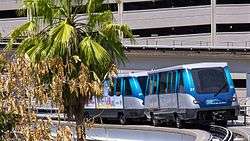Bombardier Innovia APM 100
The Innovia APM 100 (formerly known as the CX-100) is an automated people mover (APM) rolling stock first developed by Adtranz (now Bombardier Transportation), intended mainly for airport connections and light rail in towns. They are operated by Automatic Train Control (ATC), making it fully automatic and driverless.



The Innovia APM 100 is an evolution of Adtranz's previous people mover vehicle, the C-100. Bombardier's intended successor to the Innovia APM 100 is the Innovia APM 200 (originally simply known as the Innovia), which made its debut on Dallas-Fort Worth International Airport's Skylink APM. However, the Innovia APM 100 continues to be offered by Bombardier and will remain in service at many airports for years to come. In addition to being used at many airports, the Innovia APM 100 is used on the Miami Metromover which runs throughout Downtown Miami, Florida, United States.
Airport connections
A popular rolling stock for intra-terminal connection in large airports, it operates in a number of airports:
Current:
- AeroTrain, Kuala Lumpur International Airport, Malaysia
- AirTrain, San Francisco International Airport, United States
- Automated Guideway Transit System, Denver International Airport, United States
- Beijing Capital International Airport, People's Republic of China
- Madrid Barajas International Airport, Spain
- McCarran International Airport People Movers, McCarran International Airport (Las Vegas, Nevada), United States
- Orlando International Airport, United States (Gates 70-129 Only.)
- Pittsburgh International Airport People Movers, Pittsburgh International Airport, United States
- Satellite Transit System, Seattle-Tacoma International Airport, United States
- SkyBridge, Leonardo da Vinci Airport, Italy
- SkyLine, Frankfurt Airport, Germany
- SMF Automated People Mover, Sacramento International Airport, United States
- Tampa International Airport Airside, United States
- TerminaLink, George Bush Intercontinental Airport, (Houston, Texas), United States
- The Plane Train, Hartsfield-Jackson Atlanta International Airport, United States
- Tracked Shuttle System, London Gatwick Airport, United Kingdom [1]
- Track Transit System, London Stansted Airport, United Kingdom
Urban lines
Miami Metromover
The Bombardier Innovia APM 100 is used on the Metromover in Miami, Florida, United States. The trains were introduced in 2008, replacing the system's older Adtranz C-100. The Metromover is one of the world's few rail systems that uses the Innovia APM 100 for non-airport operations.
Bukit Panjang LRT

The Innovia APM 100 (C801) began operations on the Bukit Panjang LRT Line in 1999. These cars are similar to the C-100s formerly used at Singapore Changi Airport's Skytrain system in the early 1990s, jointly built by Westinghouse and Adtranz (acquired by Bombardier). Most of the new features available in newer MRT train cars are found here as well.


Instead of metal wheels on metal tracks, rubber-tired wheels on a concrete track are used making it very quiet. Also, the windows mist within 6 metres (20 ft) of (mostly) HDB apartment blocks ensuring residents' privacy. 19 individual cars (which can be coupled in pairs if necessary during peak hours) were purchased.
The line suffered numerous technical problems in its initial years, and subsequent LRT lines in Singapore used the Crystal Mover instead. SMRT also announced that they will upgrade the LRT system with full cost paid by the company.
13 more trainsets for the Bukit Panjang LRT Line (C801A) have been progressively introduced since late-2014 to ease the 100% peak hour congestion. As of 4 September 2015, all C801A trains are on revenue service.
Guangzhou APM Line
The Zhujiang New Town Automated People Mover System, or officially known as the Guangzhou Metro APM Line, is operated by a fleet of 14 Innovia APM 100 rolling stock. It serves the Zhujiang New Town area in Guangzhou, the new CBD of the city. The system began operations in November 2010 and is completely underground. In terms of construction cost per kilometre, it is the most expensive APM system in the world, yet it is the shortest and least used line in the Guangzhou Metro network.
Technical specifications
- Manufacturer : Adtranz, now Bombardier Transportation
- System operation : Automatic (Driverless)
- Gauge : Central guideway with rubber tyres
- Maximum speed : 55 kilometres per hour (34 mph)
- Capacity : 105 (22 seating, 83 standing)
- Unladen weight : 15,000 kilograms (33,000 lb)
- Size : 12.8 metres (42 ft) length, 2.8 metres (9.2 ft) width, 3.4 metres (11 ft) height.
See also
- Bombardier Innovia APM – automated people mover systems
- Light Rail Transit
- Mitsubishi Heavy Industries Crystal Mover – a competing APM rolling stock
References
- Bombardier Transportation – London Gatwick Airport Archived 22 November 2008 at the Wayback Machine
External links

- Bombardier Transportations : Bukit Panjang LRT CX-100
